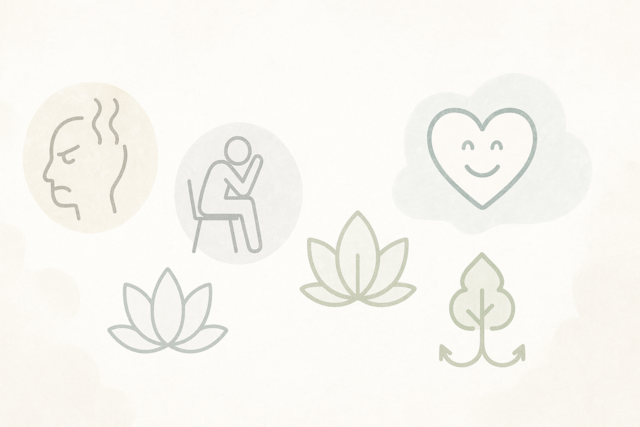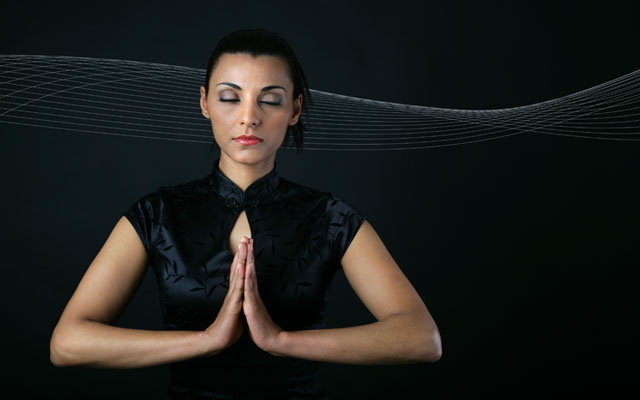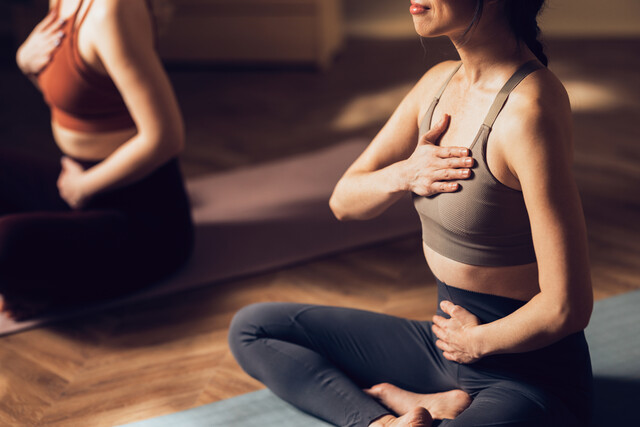Most of us, some more than others, have ingrained habits that may be limiting or preventing a natural and well-developed breath flow. We will see that, as we grow up, we acquire a considerable number of habits that may prevent us from breathing fully.
A very interesting thing to point out is that we usually are not aware of these habits � they have become such a constant in our lives, daily activities, and even personalities that they become, in a way, part of who we are.
This is not necessarily a good thing.
The whole of the body is involved in breathing, either directly or indirectly. Our abs, diaphragm, rib muscles, and intercostal muscles, for example, are involved directly in the pulling and pushing of our lungs. Meanwhile, other muscles, bones, and tissues in our body do have an influence in the way other muscles and bones move � meaning an imbalance in one area of your body will, in varying degrees, affect other areas of your body.
| A simple observation exercise: - You can do this by getting a group of friends together and having a look at one at a time, or just by paying attention to people walking on the street. - Try to find someone who walks in a very well-balanced, neutral manner. By this, we mean someone whose steps are even both in stride and weight distribution, arms evenly rocking at the side of his or her body, even shoulders, elongated spine and neck, with the head graciously floating atop. Whew! Not very easy, is it? |
A little further down this section, we will point out the "type" of people you have the best odds of finding, who have a balanced, neutral walk.
| - Pay close attention to the way others walk. Is one arm hanging lower than the other? Is he or she "favoring" one leg, putting more weight on that leg when they step? Does his or her head tilt to the side? - Very important: With what part of their bodies do they lead their walk? This can even be fun to notice. Some people lead their way with their hips. Others, with their heads sticking in front of them. A few buff guys lead with their chests or their arms arched by their sides. Interesting, is it not? - Now ask a friend to have a look at your own walk. Just walk across the room away from them and then towards them, and then listen to what they have observed. You will most likely be surprised by the things they point out: "Wow, I really do do that, don't I?" |
There was a time when you were perfectly balanced: your childhood!
- Take some time to observe the way babies and young children move. They are very efficient. Do they have a lot of imbalances? If they walk, is it a walk full of tension and learned habits? Probably not. Kids haven't yet learned how to be tensed up or how to not distribute their weight well: Their posture is usually great, their pelvis being the center of gravity and movement of their near-perfect alignment.
But don't worry. Just like these things can be accidentally learned, they can be unlearned.
The first step to unlearning these habits is to be very aware of them and what is causing them. Over the course of our lives, we soak up, just like a sponge, a huge number of habits that are dictated by the things around us, and the way we respond to them. Things like the sports or activities we did or didn't do when we were growing up; being called names for being too tall (making us crouch), or too short (making us tense our necks up), our diets, the emotional struggles and events we have had to go through, jobs we had to do. A all of these things have an influence on the way our bodies move at this very moment. Physical memory is a very real, concrete thing. Because we slowly and unconsciously absorb these habits and movement patterns, little by little, day-by-day, we are usually not aware of them.
For example, let's say you walk with stiff hips. That may very well be causing breathing problems, by causing your abdominal muscles to do extra work and, in turn, to get tensed up. By working on releasing and relaxing your hips, you would be also working on relaxing your abdominal muscles, which in turn would allow the diaphragm to move more freely, and the ribs to expand further, giving you a much different control over your breathing, in a positive way!
Aside from the tensions and habits we have in our muscles, joints, and bones, we also tend to have the particular habit of holding our breaths.
Holding your breath can be useful when used in appropriate situation, but very, very limiting when used in situations where your breathing would only benefit from flowing freely.
What happens to your breathing when someone hands you a super heavy box to carry up the stairs? Or when you count 1, 2, 3! and start pushing that piano across the street? Here is when holding your breath is useful, and it happens, arguably, in an instinctive way: By holding your breath, your torso gets firmer, providing a sort of anchor point for your arms and shoulders to work from.
In a similar way, almost without noticing, our breathing suspends when we feel danger around us. Wait � did I just hear someone trying to open the door? � � We go immediately into silent mode, barely breathing in order to pay attention to our surroundings.
There is a different type of danger, or fear, that we all feel around us, but one from which we will not at all benefit from holding our breaths. Our daily fears, the ones that don't actually threaten our survival (in the most primal sense): fear of failing, of embarrassing ourselves, of "doing something stupid," of saying something silly. Many times, we respond to those situations by holding our breaths and restricting the airflow.
These are the times when you will most need to breathe to your full potential, freely and confidently! By being able to control your breathing patterns, even if your mind is telling you there is a fear of failure, or embarrassment, you will be able to respond appropriately to these fears by breathing fully and freely. The advice "take a deep breath" is useful, but what we really want is for every breath to be deep, full of intention, and potential.
|
- So work on your habits. Now that you know about them, make a conscious and daily effort to get rid of them. If you lean your head to the side when walking, make it a goal to walk with your head beautifully balanced on the very top of your neck.
- Become informed and practice lots of different stretches. Stretching is a wonderful way of discovering muscles you didn't even know existed, as well as finding out which parts of your body are tensed up and need release. Stretching daily, once in the morning and once at night, is one of those simple things that will improve your daily life � and your breathing. - Experiment with breathing in different positions. Standing up, you will breathe like you usually do. But what happens when you breathe lying down, with your feet up in the air? When you breathe crouched over in a ball? When you breathe with your neck relaxed, on all fours? You will notice that your breathing will feel different, because different muscles are at work � some are releasing the tension you hold when you stand up, and others are stretching more than usual. This is a great way of becoming aware of your own body and discovering which muscles can help you with being in full control of your breathing. |
A Philosophical Look
It is undeniable that we affect the lives of other people, animals, and living things, directly and indirectly, through our actions.
"I asked someone out on a date today."
"I made someone mad today."
"I came into work and did all my tasks."
Often times we do not realize how big are the consequences of our smallest actions. Have you ever gone into a store, and the cashier was so nice that it brightened the rest of your day? You make an impact, small or big, whenever you make eye contact with someone. Whenever you say a word to them. Whenever someone watches you as you pay a bill, cross the street, or open a door.
This relates to breathing in a fundamental way. We have seen that when we are in control of our breathing, we are in control of our body, thoughts, and emotions; we are allowing ourselves to be closer to who we really are, and being able to act and react in a manner that is truthful to our beings. When we say, "I don't know why I reacted like that," what we are really saying is, "I didn't act truthfully or in accordance to who I am and would like to be!"
When you inhale, you are inhaling both the good and the bad energies you see around you all the time. If you have been in a room full of cranky people, you will know how contagious this energy can be. Likewise, positive, optimistic people inspire us to act in a similar manner.
When you exhale, you actually have a choice. What is it that you are giving the world? Are you exhaling negativity, anger, and bitterness? Or are you sharing kindness, happiness, and positivity?
But you are not the only person who will enjoy the benefits of breathing fully and freely. All of those around you, and hopefully those around them, and those around them, etc. etc., will experience the positive changes a breath full of positive purpose can trigger.
| In the end, The Art of Breathing gives us tools and allows us to get closer to what we all look forward to in life: ? A positive attitude toward people and situations, with the ability to act and react truthfully and in accordance to who you really are; ? Lasting, endearing relationships. When you are in touch with yourself, you become more pleasant to others, as well. You will notice a difference not only in the way you see yourself, but also in the way your relationships will evolve -- be it with friends, family, romantic connections, or even strangers. ? Living in the moment. We all wish to be forgiving and accepting of the past, as well as to not worry in excess about the future. Often times, we are not only caught up in whatever next thing is about to happen, but we are still being dragged backwards by all the things that happened in our pasts, because we still believe they are a type of commentary, or evaluation, about our true self. When that happens, we believe we have to explain and justify everything we have done. If you know who you are and become your own best friend, it becomes much easier to turn doubts into something positive! When your breath is yours, you learn to just be, here andnow. ? "Reclaiming yourself," and leading a happier life! |
Mantras are supposed to flow naturally and effortlessly, allowing one-pointed focus to travel through this channel of attention, in order to arrive at a deep mental state of thoughtful awareness and control. Usually they have no particular meaning -- that is, a mantra is not necessarily a sentence that "makes sense" in terms of spoken language.
We are always breathing. When we do so in a positive manner, that means we are always stimulating and inducing positive transformation and promoting positive aspects in our lives. The more we breathe with purpose, the more of this positive enlightenment we experience on both ends � receiving and giving out to the world.
Just like mantras, we want our breathing flow naturally, truthfully, and effortlessly. It is a somewhat contradictory thing that, in order to achieve effortless breathing, there is a lot of effort to be done in preparation, especially for grown adults. Once this sense of effortlessness is achieved, though, you can maintain it for the rest of your life; you only have to continue to be mindful and aware of your own body, tensions, and habits.
So this continued mantra, in the form of breathing, will help you regain control of a huge number of situations in your life. The art of breathing will help improve your life in short, medium, and long terms, in relation to issues and situations large and small. And most importantly, in relation to yourself and the people around you.
Before we move on to a list of some exercises that you will find useful and will be able to consult in your day-to-day life, as needed, let's conclude with a breathing and relaxation exercise.
| - Find a quiet place, and chose to either be sitting or lying down. Take a moment to notice your breathing; where it is coming from, what muscles are involved, how fast and how intense it is at the moment. - Close your eyes. In this exercise, you will visualize your body getting heavy. - Start with your feet. Imagine that your toes and the rest of your feet are turning into heavy, rock-hard concrete. - Take the time to really feel yourself getting heavy. - After a few moments, continue to do the same as you move up your body: ankles, knees, thighs, pelvis, stomach, chest, arms, shoulders, neck, everything up to the very top of your skull.
|
You may fall asleep during this exercise; it really is okay if you do. That shows that your body was actually waiting for this moment, for the opportunity when it could be fully relaxed and seek some relief to the heaviness to which we submit ourselves everyday.
| Remember: YOU are in control, both of your breathing and of your life. You are strong and independent from all outside influences: you control the positive and the negative in yourself! |


























